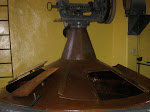
Have I mentioned my fondness for German beer?
I believe so. It's not just that the Germans make a diverse range of extraordinary beers. It's not just that Germany has given us some of the world's
great beer styles. Heck, it's not even just because the Germans, rightly or otherwise, refuse to brew with adjuncts or other flavorings and reliably churn out quality and variety in spite – or, more probably, because – of this.
These are all good things, and any single one would compel our admiration. But on top of all that, you've just got to love German beer because
Germans love it so much, too. Need proof? Check out this big honker of a beer mug brought to us by
Warsteiner, at one liter in capacity a veritable bucket of joy
and an apt physical representation of the Germans' legendary thirst.
In its native land, this voluminous mug and others like it go by the name
Maß (pronounced "mass"), which is short for
Maßkrug. Stoneware or glass, decorated or otherwise, the Maß can come in any number of configurations (
here I am drinking from the commonly seen dimpled version), though the constants tend to be its ample volume – one liter – and its handle.
In and around Munich, where grand beer halls and gardens typify the German taste for high-volume beer service and consumption, the roomy Maß further obliges this penchant in appropriate fashion.
And this is to say nothing of
Oktoberfest, the world's largest beer-drinking party, wherein natives and foreigners converge on Munich to hoist Maßkrüge (approximately 7 million liters' worth!) in unapologetic indulgence of world-class beer. Take away the Maß, brimming with beer and joyfully swung side to side by hearty revelers, and our image of Oktoberfest, the zenith of Germany's propensity for beer appreciation on a large scale, would hardly be the same.
The Maß is most often used for your everday-drinking beer. In Munich, this is usually the delightful
Helles, a staple of Bavarian beer halls and gardens, flavorful enough to demand all-day consumption yet light enough in alcohol to allow it. The Warsteiner Maß pictured above, meanwhile, is intended for use with that brewery's signature
Pilsener. During Oktoberfest, as you might imagine,
Oktoberfestbier is the brew of choice, which these days displays less of the amber color and maltiness of its cousin
Märzen, instead tending to be light and Helles-like.







